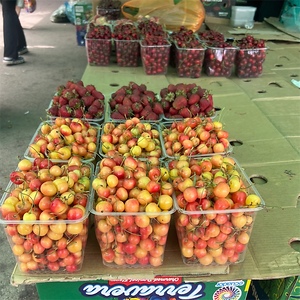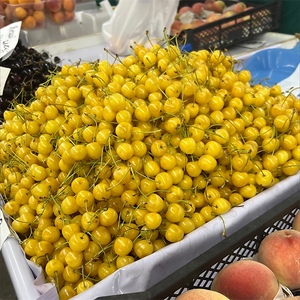


Yellow Drogan Cherries
Estimated Inventory, lb : 0
Description/Taste
Yellow Drogan cherries are a small to medium-sized varietal, averaging 2.2 to 2.5 centimeters in diameter, and have a round to cordate shape with curved, sloping shoulders and a blunt base. The fruits range from 6 to 7 grams in weight, sometimes reaching as heavy as 9 grams, and are attached to long and slender green stems. Yellow Drogan cherries ripen from pale yellow to rich, golden yellow hues, and the skin is smooth, glossy, taut, and thin. The skin is so delicate that it can easily be punctured, torn, or bruised. Underneath the surface, the straw yellow flesh is firm, semi-translucent, and aqueous, with a tender, crisp, and succulent consistency. The flesh also encases a central, tan, elongated, and tapered stone. Yellow Drogan cherries are edible raw once ripe and are known for their high sugar content and low acidity, creating a sweet and subtly tangy, fruity
Seasons/Availability
Yellow Drogan cherries are available in the summer, typically from the end of June through early August in Europe and Central Asia.
Current Facts
Yellow Drogan cherries, botanically classified as Prunus avium, are a yellow-fruit variety belonging to the Rosaceae family. The sweet cherry cultivar was developed in Germany and has since expanded in cultivation across Eastern Europe and Central Asia. Yellow Drogan cherries are a popular mid to late-season commercial cultivar in the summer, and the variety is known under several names, including Drogana Yellow, Droganova, Drogana Zheltaya, Drogan’s Yellow Bigarreau, and Drogan’s Gelbe Knorpelkirsche. Growers favor Yellow Drogan cherries for their high yields, disease resistance, and frost and drought tolerance. The trees begin bearing fruit approximately 4 to 5 years after planting, and the cherries tend to ripen simultaneously, allowing for easier harvesting. Yellow Drogan cherries do not fall from the tree when ripe and must be hand-picked to protect their delicate nature. The fruits cannot be shipped long distances due to their thin skin and are typically sold in their growing regions. Despite their fragility, Yellow Drogan cherries produce over 15 kilograms of fruit per tree each season, and consumers favor the fruits for their sweet, refreshing flavor and juicy, tender flesh. Yellow Drogan cherries are considered a table variety and are widely consumed fresh or incorporated into sweet and savory culinary preparations.
Nutritional Value
Yellow Drogan cherries have not been studied for their nutritional properties. Cherries, in general, are a source of magnesium to help control nerves, vitamin E to guard the cells against the damage caused by free radicals, vitamin C to strengthen the immune system, and potassium to balance fluid levels within the body. Cherries also provide fiber to regulate the digestive tract, phosphorus to repair tissues, vitamin A to maintain healthy organ functioning, and other nutrients, including manganese, vitamin K, and copper.
Applications
Yellow Drogan cherries have a sweet flavor suited for fresh and cooked preparations. The variety is known for its fleshy, juicy, and succulent nature and is primarily consumed out of hand as a snack. Yellow Drogan cherries can be used as a topping over cakes, tarts, salads, crepes, and porridge or as a sweet addition to fruit medleys. The cherries can also be blended into juice as a sweet flavoring in cocktails, sparkling beverages, smoothies, and shakes. In addition to fresh preparations, Yellow Drogan cherries are popularly simmered into jams, jellies, and compotes. The fruits are also cooked into syrups and used to flavor tea and other beverages. In Russia, cherries are often cooked into a homemade fruit drink called kompot. Yellow Drogan cherries can also be stewed and poured as a sauce over roasted meats, desserts, or ice cream. The fruits add a mild sweetness to baked goods such as bread, cakes, scones, crumbles, and pies, or they can be cooked with spices and flavorings as a filling. Beyond culinary recipes, Yellow Drogan cherries are sometimes canned or dried for extended use. Yellow Drogan cherries pair well with herbs such as mint, cilantro, basil, and thyme, spices including nutmeg, cinnamon, ginger, and allspice, nuts such as pecans, almonds, and walnuts, and fruits including blueberries, peaches, and apricots. Whole, unwashed Yellow Drogan cherries have a short shelf life and are easily damaged in handling, leading the cherries to only keep for a few days when stored in the refrigerator. The variety should be immediately consumed for the best quality and flavor. Yellow Drogan cherries are not suitable for freezing.
Ethnic/Cultural Info
Yellow Drogan cherries are often referred to as Drogan Gelbe Knorpelkirsche cherries in Germany. This name is given to the variety in honor of the fruit’s breeder, only known as Drogan in records, and the descriptor "gelbe" translates to mean "yellow" while "knorpelkirsche" means "cartilage cherry." Knorpelkirsche is a term used to describe the fruit's firm flesh. One of the unique characteristics of yellow cherry varieties, including Yellow Drogan, is that they are more likely to survive in orchards against birds in Europe and Central Asia. Birds are notorious for eating sweet cherries, especially red ones, but yellow cherries have an advantage as they blend in better and hide within the branches and leaves. It is harder for birds to see yellow cherries compared to the bright shades of red cherries, typically encouraging birds only to eat red fruits.
Geography/History
Yellow Drogan cherries are native to Europe and were thought to have been discovered as a chance seedling in Germany. Much of the variety’s history is unknown beyond its origins in Germany and possible ties to the Saxons, a Germanic people group in Northern Germany. The parental varieties of Yellow Drogan cherries are also unknown. Over time, Yellow Drogan cherries expanded beyond Germany and became a cultivated tree in other regions of Eastern Europe and Central Asia by the mid-20th century. Yellow Drogan cherries are a popular variety in Russia in the modern day. The variety is commercially produced and planted in home gardens, and the seasonal fruits are harvested as a summer delicacy. Today, Yellow Drogan cherries are a widely distributed yellow-cherry variety in Europe and Central Asia, especially in Ukraine, Germany, Bulgaria, Russia, Georgia, Azerbaijan, Kazakhstan, Armenia, Moldova, and Georgia. The Yellow Drogan cherries featured in the photograph above were sourced through a weekend farmer’s market in Almaty, Kazakhstan.









